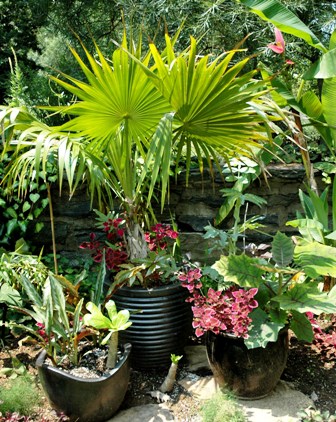Since there were several queries and comments on my post about the containers at Chanticleer, I mentioned that I would try to contact Dan Benarcik, the horticulturist who is the designer of several of these containers to get his input on the ‘hows’, ‘whats’, etc. I was lucky enough to run into Dan on Saturday at Starbucks where we sat and chatted a bit about how he actually maintains these extravagant creations.
 Dan said that he was happy that others seemed to have a better grasp on how he designs and maintains the containers than he does at times. In a very self deprecating tone, he explained that the gardening season at Chanticleer is so intense that once he pots up the containers, it is with the intent that they will last the entire season with no changes. Dan said that he loses about 10% of the plant material throughout the season. It is only then that he replaces a plant. Otherwise, outside of the forced bulbs that can be seen in the containers this week when Chanticleer opens to the public, from mid-spring straight through the fall season, visitors are observing the identical container vignettes: developing from infancy to maturity.
Dan said that he was happy that others seemed to have a better grasp on how he designs and maintains the containers than he does at times. In a very self deprecating tone, he explained that the gardening season at Chanticleer is so intense that once he pots up the containers, it is with the intent that they will last the entire season with no changes. Dan said that he loses about 10% of the plant material throughout the season. It is only then that he replaces a plant. Otherwise, outside of the forced bulbs that can be seen in the containers this week when Chanticleer opens to the public, from mid-spring straight through the fall season, visitors are observing the identical container vignettes: developing from infancy to maturity.
Now, as far as fertilizing the pots, Dan said that he is lucky if his schedule affords him the opportunity of getting to that task about once a month. What product does he use? I forgot to ask. And if you think he’s watering these exuberant plantings two or three times a day, you’re wrong. Once in the morning…and that’s it.
So for those of you who thought that there was alot of primping and fussing in the maintenace of these over the top couture containers, it looks like you need to become acquainted with the world of ‘Container Gardening According to Dan Benarcik’. His is a no nonsense, straightforward approach: along with a great flair for design and a deep love and knowledge of plant material!
